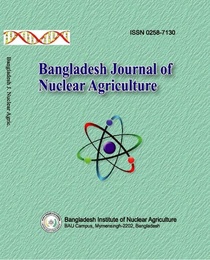IN VITRO EVALUATION OF FUNGICIDES AND BIOCONTROL AGENTS AGAINST Sclerotium rolfsii AND Sclerotinia sclerotiorum
Abstract
An experiment was conducted in the laboratory of Plant Pathology Division of Bangladesh Institute of Nuclear Agriculture (BINA) during September 2021 to February 2022 to evaluate the efficacy of five fungicides and three biocontrol agents against two soil borne fungi, Sclerotium rolfsii and Sclerotinia sclerotiorum. Five chemical fungicides viz. Dithane M-45, Bavistin 50 DF, Ridomil Gold MZ 68 WP, Antracol 70 WP and Secure 600 WG and three biocontrol agents viz. BC1 (Trichoderma harzianum), BC2 (T. harzianum) and BC3 (T. viride) were evaluated. The sensitivity of the fungicides against S. rolfsii and S. sclerotiorum was tested by poison food technique. The antagonistic activity of the biocontrol agents was evaluated against the fungi through dual culture technique. Among the tested fungicides, the highest inhibition of mycelial growth (83.2% for S. rolfsii; 71.9% for S. sclerotiorum) and reduction of sclerotia production (44.8% for S. rolfsii; 34.4% for S. sclerotiorum) was recorded for Bavistin 50 DF. The biocontrol agent BC1 showed the highest inhibition of mycelial growth (78.2% for S. rolfsii; 39.4% for S. sclerotiorum) and reduction of sclerotia production (40.6% for S. rolfsii; 37.5% for S. sclerotiorum) for both fungi. Therefore, the biocontrol agent BC1 can be useful to suppress S. rolfsii and S. sclerotiorum.
References
Amin, F., Razdan, V.K., Mohiddin, F.A., Bhat, K.A. and Banday, S. 2010. Potential of Trichoderma species as biological agent of soil borne fungal propagules. J. Phytopath. 2: 38-41.
Anand, S. and Singh, H.B. 2004. Control of collar rot in mint (Mentha spp.) caused by Sclerotium rolfsii by biological means. Current Sci. 87(3): 632-637.
Barari, H. and Dalili, A. 2016. Antagonistic effects of Trichoderma spp. in the control of Sclerotinia sclerotiorum and in comparison with chemical fungicides J. Plant Dis., 4 (2): 13-26.
Bashar, M.A. 1990. Ecopathological studies on Fusarium oxysporum f. sp. cicerni causing wilt disease of chickpea. Ph. D. Thesis. Banaras Hindu University. India. p.158.
Chet, I. Brotman Y. and Viterbo, A. 2009. Trichoderma an environment-friendly biocontrol agent of plant disease. Proceeding of the 5th International Conference on Biopesticides: Stakeholder Perspectives. New Delhi.
Darvin, G., Venkatesh, I. and Reddy, N. G. 2013. Evaluation of Trichoderma spp. against Sclerotium rolfsii in vitro. International Journal of Applied Biology and Pharmaceutical Technology. 4(4): 268-272.
Goswami, K., Tewari, A.K. and Upadhyay, P. 2020. In vitro evaluation of fungicides against mycelial growth and sclerotial viability of Sclerotinia sclerotiorum (Lib.) de Bary, the cause of Sclerotinia rot of Rapeseed-mustard. J. Pharmacognosy and Phytochem. 6: 285-290.
Grover, R.K. and Moore, J.D. 1962. Toxicometric studies of fungicides against brown rot organism, Sclerotinia fruiticola and S. laxa. Phytopathology 52: 876-879.
Gulya, T., Harveson, R., Mathew, F., Block, C., Thompson, S., Kandel, H., Berglund, D., Sandbakken, J., Kleingartner, L. and Markell, S. 2019. Comprehensive disease survey of U.S. sunflower: disease trends, research priorities and unanticipated impacts. Plant Dis. 103: 601-618.
Haddad, P.E., Leite, L.G., Lucon, C.M. and Harakava, R. 2017. Selection of Trichoderma spp. strains for control of Sclerotinia sclerotiorum in soybean. Research Agropecu. Bras. 52 (12): 1140-1148.
Hemanth, G., Kumar P.K.R., Niharika P.S. and Kolli, S.K. 2016. Fungicides effect on soil micro flora in Tekkali Mandal, Srikakulam (Dist.). Int. J. Res. Dev. Pharm. Life Sci. 5(4): 2245-22.
Jegathambigai, V., Wijeratnam, R.S.W. and Wijesundera, R.L.C. 2010. Effect of Trichoderma sp. on Sclerotium rolfsii the causative agent of collar rot on Zamioculcas zamiifolia and on farm method to mass produce Trichoderma sp. Plant Pathol. J. 9 (2): 47-55.
Johnson, M, Reddy, P.N and Reddy, D.R. 2008. Comparative efficacy of rhizosphere mycoflora, fungicides, insecticides and herbicides against groundnut stem rot caused by Sclerotium rolfsii. Ann. Plant Prot. Sci. 16(2): 414-418.
Keinath, A.P. and Batson, W.E. 2020. Evaluation of biological and chemical seed trteatments to improve stand of snap bean across the Southern U S. Crop Prot. 19: 501-509.
Kolte, S.J. 1985. Rapeseed-mustard and sesame diseases, In: Diseases of Annual Edible Oilseed Crops, CRC Press, Boca Raton, Florida, 135.
Mathew, F., Harveson, R., Block, C., Gulya, T., Ryley, M., Thompson, S. and Markell, S. 2020. Sclerotinia sclerotiorum diseases of sunflower (white mold). Plant Health Instructor. DOI: 10.1094/PHI-I-2020-1201-01.
Mello, S.C.M., Ávila, Z.R., Braúna, L.M., Pádua, R.R. and Gomes, D. 2007. Trichoderma strains for the biological control of Sclerotium rolfsii Sacc. Phytosanitary.11(1):3-9.
Rini, C.R. and Sulochana, K.K. 2007. Usefulness of Trichoderma and Pseudomonas against Rhizoctonia solani and Fusarium oxysporum infecting tomato. J. Trop. Agric. 45:2-8.
Sab, J., Nagaraja, A. and Nagamma, G. 2014. Efficacy of bio-pesticides against Sclerotium rolfsii causing collar rot of chickpea (Cicer arietinuml). The Bioscan. 9(1): 335-339.
Shaigan, S., Seraji, A. and Moghaddam, S.A.M. 2008. Identification and investigation on antagonistic effect of Trichoderma spp. in tea seedlings white foot and root rot (Sclerotium rolfsii) in in vitro condition. Pakistan J. Biol. Sci. 11: 2346-2350.
Siddique, M.N.A., Ahmmed, A.N.F., Mazumder, M.G.H., Khaiyam, M.O. and Islam, M.R. 2016. Evaluation of some fungicides and bio-agents against Sclerotium rolfsii and foot and root rot disease of eggplant (Solanum melongena L.). The Agriculturists 14(1): 92-97.
Troian, R.F., Steindorff, A.S., Ramada, M.H., Arruda, W. and Ulhoa, C.J. 2014. Mycoparasitism studies of Trichoderma harzianum against Sclerotinia sclerotiorum: evaluation of antagonism and expression of cell wall-degrading enzymes genes. Biotechnol. Lett. Oct; 36(10):2095-101.
Vinodkumar,S., Indumathi, T. and Nakkeeran, S. 2017. Trichoderma asperellum (NVTA2) as a potential antagonist for the management of stem rot in carnation under protected cultivation. Biol. Control. 113: 58-64.
-
Download



